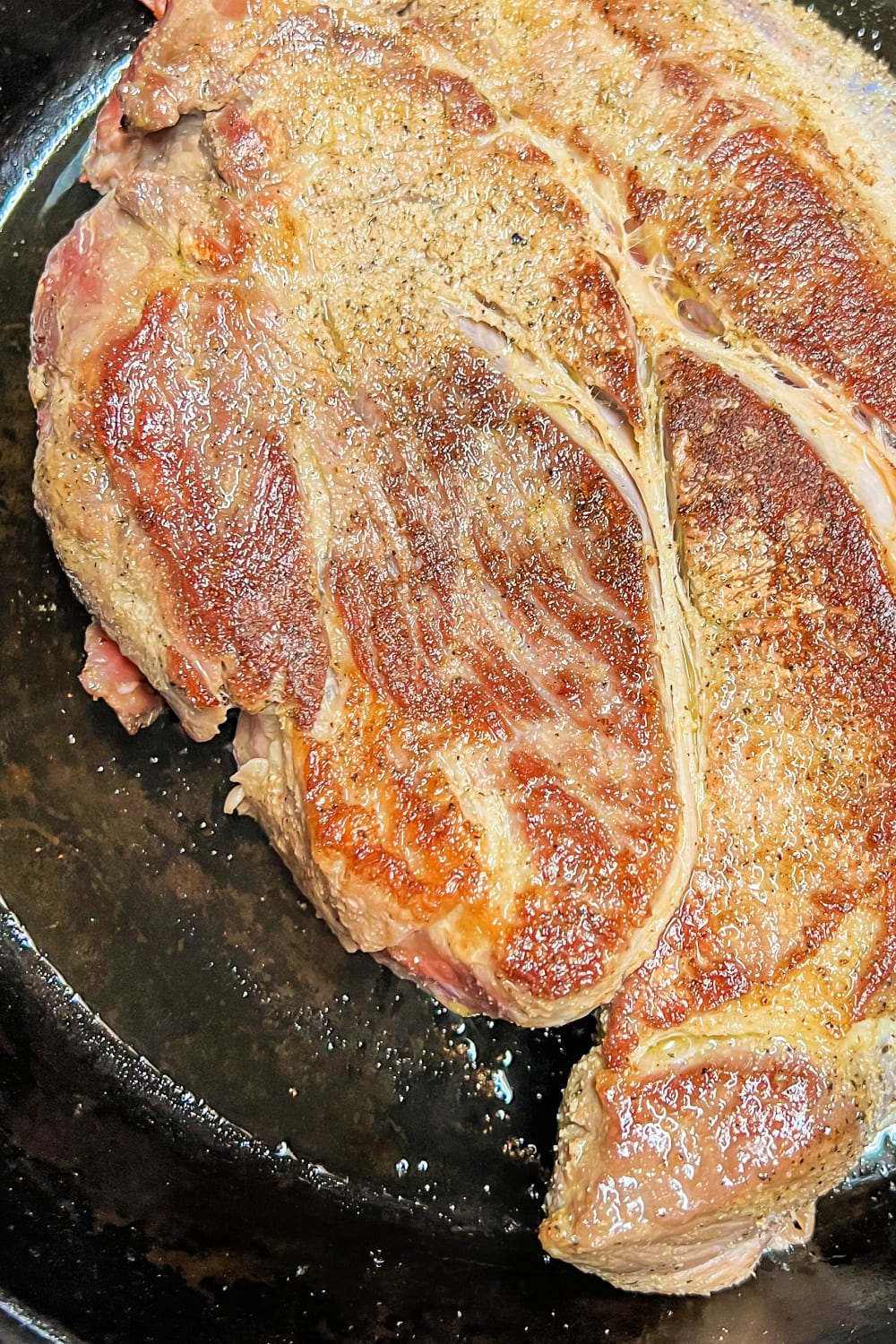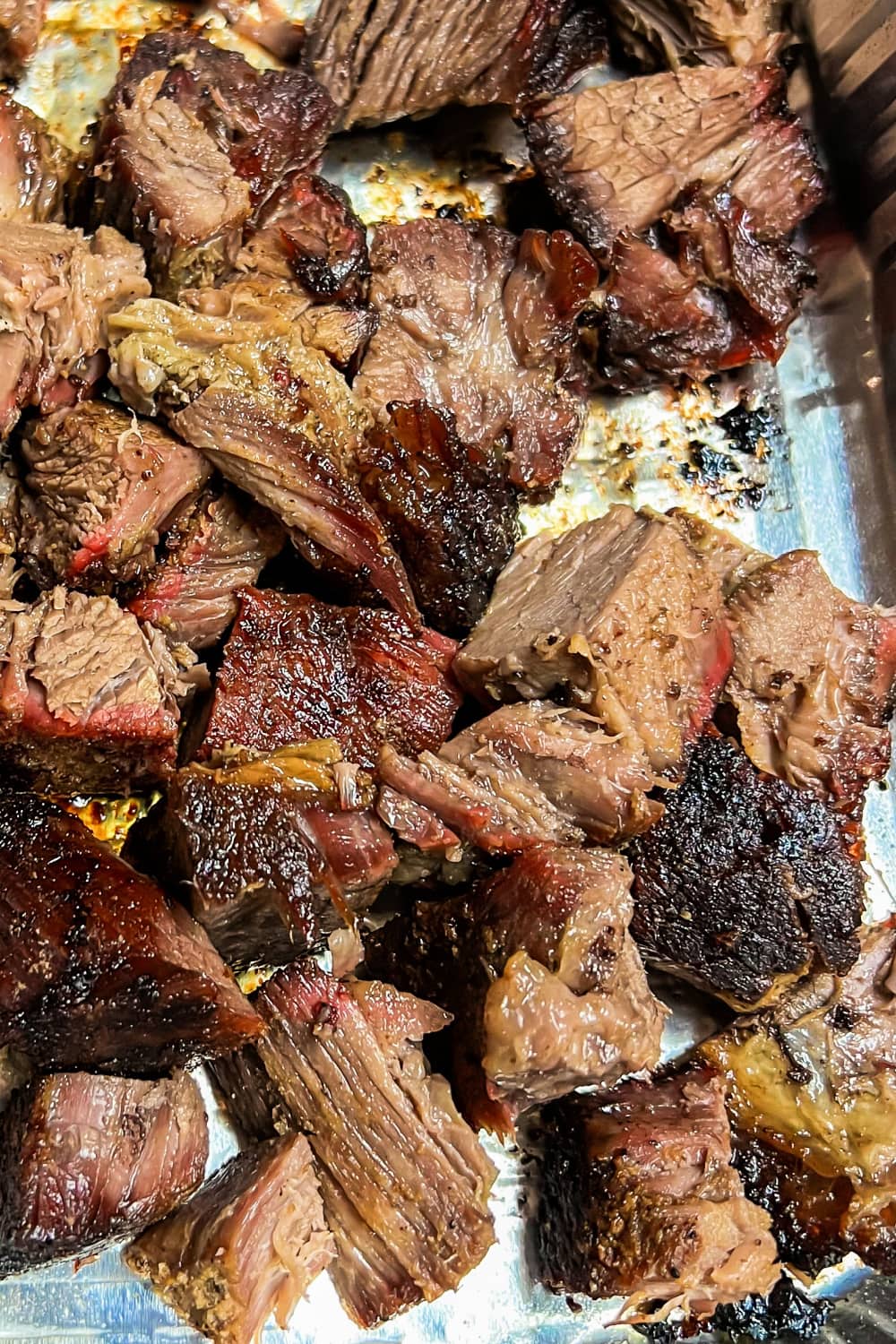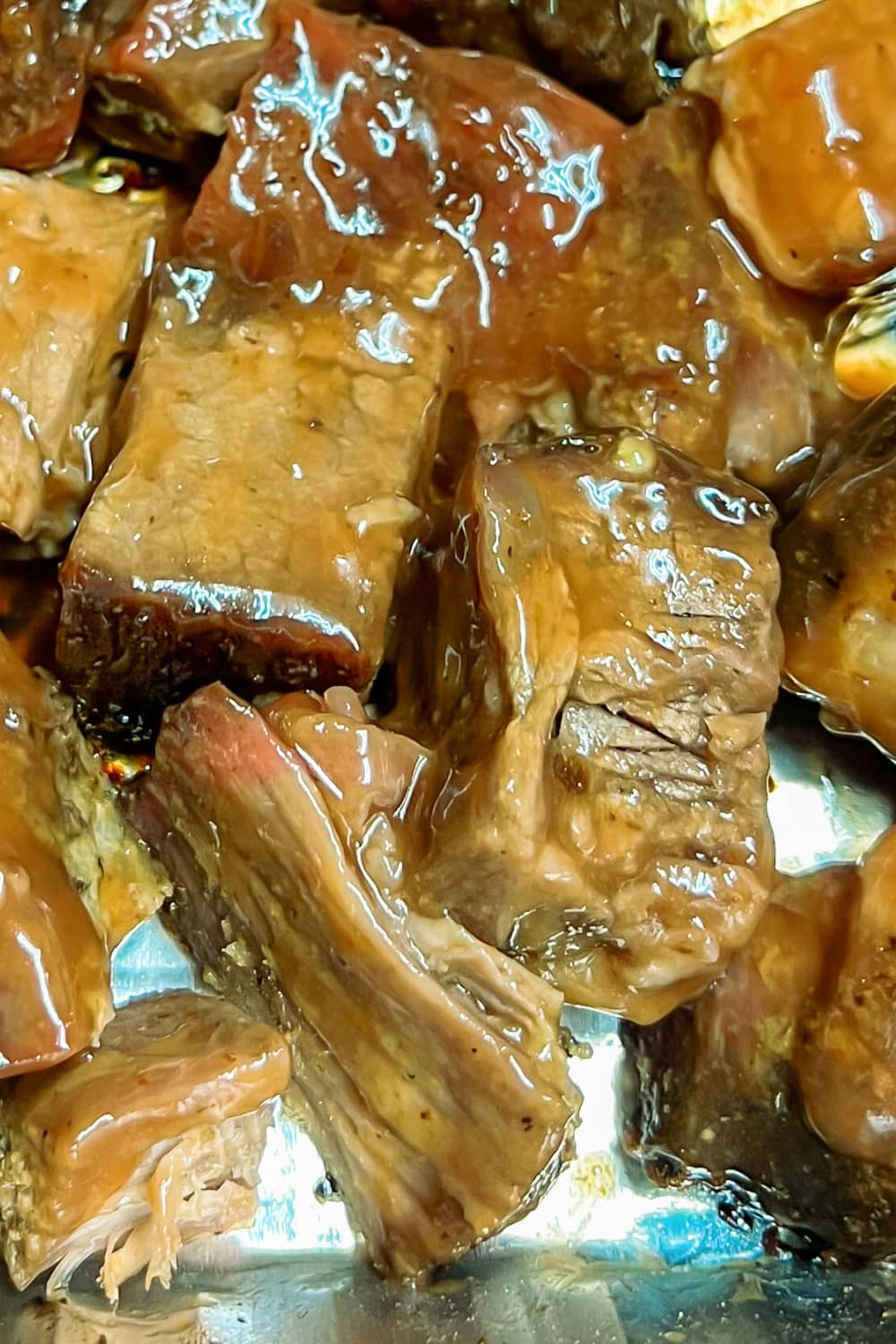Smoked Pot Roast Burnt Ends
Crank up your smoker! Made from an economical beef chuck roast, instead of expensive brisket, Smoked Pot Roast Burnt Ends dish out the savory, rich flavor we all yearn for. Smoker burnt ends made from a chuck roast come out extremely tender, with good bark and great smoke.

Smoked Pot Roast Burnt Ends Recipe
Burnt ends. My favorite thing on the menu at nearly any barbecue joint, for sure. I had no idea you could make them at home right on your very own smoker with little effort.
And now, thankfully, you can make burnt ends that taste delicious but don’t break the bank! Instead of using an expensive brisket to make burnt ends, just grab yourself a good chuck roast.
You’ll quickly learn that burnt ends made from a beef pot roast are phenomenal! I was pleasantly surprised and have been making them this way ever since.
Save this Recipe
Enter your email address and we will send you this recipe to your mailbox for easy reference! Plus, we will send you our latest recipes every week!
We also love a good Smoked Mississippi Pot Roast. Have you tried this recipe yet?!
What are burnt ends all about? And why (exactly) are they called burnt ends?
Contrary to the name, burnt ends aren’t actually burnt. Traditional burnt ends are made from beef brisket. Burnt ends are the perfect combination of tender and juicy meat with crispy edges (called bark) and an intensely smoky flavor.
What to love about this recipe
- You’ll swear you’re eating BRISKET burnt ends.
- Chuck roast burnt ends won’t break the bank.
- Everybody loves smoked beef!
Here are the ingredients you need to make burnt ends
Burnt Ends
- Chuck roast
- Kosher salt
- Black pepper
Sauce
- Ketchup
- Red wine vinegar
- Whiskey or bourbon
- Chipotle sauce or minced chipotles
- Brown sugar
- Granulated garlic
- Worcestershire

What you’ll learn from this recipe
- The best ingredients for making tender burnt ends with sauce
- Why a chuck roast works fine for making burnt ends
- The importance of cooking by temperature and doneness, not just by time
- Why making burnt ends is a low-and-slow smoker process
- What to serve with burnt ends
How to make smoked beef burnt ends step-by-step

Pat the chuck roast dry with paper towels to remove any exterior moisture. At this point, be sure your roast has rested (unwrapped) on the counter for 1-2 hours so that most of the chill from refrigeration has removed itself from the meat. In other words, the chuck roast should not be COLD!

Combine the salt and pepper. Using your fingertips season the roast on all sides, pressing the seasoning into every area of the meat. **If time allows, season the chuck roast the day before you want to make the burnt ends. Let the seasoned roast rest in the fridge for 18-24 hours, UNCOVERED. Letting the seasoned roast rest uncovered will greatly enhance it’s ability to make a really good charred crust over the exterior of the roast as it smokes.

Preheat the smoker to 275 degrees F. While the smoker is preheating, sear the seasoned roast in your favorite cast iron skillet. Over medium high heat, add a good drizzle of olive oil. When the oil is nicely hot, add the seasoned chucked roast, searing it until deeply browned on both sides.

Remove the seared roast from the skillet, placing it directly onto the rack of the preheated smoker or even into a pan that goes on the smoker like my Hubs did. Insert the temperature probe into the center of the meat. Using the probe allows you to see the internal temperature of the roast from outside the smoker, never having to open the lid and lose all your heat.
Smoke the roast, uncovered, until it reaches 165 degrees F. internal temperature at the center.**This step will take approx. 4-5 hours, depending on the size of your roast.
Once the chuck roast reaches 165 degrees F. at the center, remove it from the smoker, wrapping it tightly in foil. Return the roast to the smoker, letting it smoke until the internal temperature at the center reaches 195 degrees F.**This step should take about 1 hour.
While the roast is smoking, prepare the sauce by combining all the ingredients in a saucepan over medium high, whisking until smooth. Lower the heat and simmer the sauce until it is nicely thickened.

Remove the chuck roast from the smoker, letting it rest for 15 minutes. Unwrap the roast, placing it onto a large cutting board. Cut the roast into 1-inch or 1 1/2-inch cubes, placing them into a disposable aluminum baking pan.

Pour half of the prepared sauce over the beef cubes; toss the beef to be sure all the cubes are coated with the sauce.
Place the pan of sauced beef cubes onto the smoker rack and cook for another 2 hours or so, until the burnt ends are very fork-tender.
Serve the burnt ends with the remaining sauce (warm), as desired. Enjoy!\

Answers to Common Questions Asked About This Recipe
Besides a smoker, which tools are helpful for making burnt ends?
Aluminum pans – I like using aluminum pans because they are disposable – such easy clean up. Plus, I cook a lot of meals for friends and family and I like to be able to provide that in an aluminum pan so I don’t have to worry about getting the pan back.
Cutting board – everybody needs a good, large wooden cutting board. For slicing/cubing meat, you’ll want with with a channel around the outer edge so the juices can gather here.
Chef’s knife – an absolute must-have in the kitchen, no matter what you are slicing, chopping, or dicing! My hands are on the larger size, so I like an 8-inch chef’s knife. Many women with smaller hands prefer a 6-inch chef’s knife.
Long-handled tongs – these are handy at the smoker, grill, or even at the stove. I like a good pair of 16-inch stainless steel tongs with silicone tips that lock.
Meat thermometer – so that I don’t have to open my smoker lid or oven door and lose heat, I really love a digital meat thermometer with a probe. This one isn’t expensive at all and you can set it to let you know when the internal temperature reaches the temp you want. Super handy.
Why are burnt ends made from brisket so expensive?
Burnt ends made from brisket are delicious, no doubt about it; the only down side is the COST. Supply and demand drives up the cost of a brisket – it’s a very popular cut of beef and each cow that is harvested only produces two briskets.
What makes chuck roast burnt ends more economical than brisket burnt ends?
Chuck roast lends a lot of flavor on a budget when you want to make burnt ends. Compared to brisket, it’s much more economical and results in tender and juicy nuggets of beef.
Why does chuck roast work well for making burnt ends?
Chuck roast is a shoulder muscle that gets a lot of use on a cow, giving it tremendous marbling and flavor. All that good marbling is also what give chuck roast a good amount of fat and this keeps it from getting to dry as you smoke it to make burnt ends.
Smoking a chuck roast to make burnt ends is easy to do and low maintenance. Think low-and-slow for chuck roast burnt ends that are tender and juicy.
What does low-and-slow cooking mean for smoking burnt ends?
Regardless of whether you use brisket or chuck roast for making burnt ends, you’ll need to be sure the meats gets plenty of time on the smoker, cooking at a low temperature, 225 – 275 degrees F for most burnt end recipes.
Why is cooking/smoking burnt ends low-and-slow so important?
Low and slow smoking or cooking is essential for burnt ends that are tender, meaty, and succulent. Cooking them any other way results in tough, chewy, and dried out beef…..a very undesirable eating experience!
When meat cooks low and slow, the connective tissues break down and gelatinize as the fat melts and moisturizes the meat. Only low and slow cooking will allow the meat to become the fall-apart-tender that we all desire.

Why should meat never be cooked or smoked just by TIME alone?
The cooking time stated on a recipe is just a guide….especially when it’s a MEAT recipe. Because there are lots of variables to consider when we’re cooking, we want to utilize three very essential things to ensure we are successful:
- Time
- Internal temperature
- Tenderness
Time – The cooking time of a recipe provides us with a range of how approx. how long a recipe will take to prepare and then cook. This amount of time is never set in stone since ingredients can vary in temperature, size and structure, just as ovens, grills, and smokers can vary in how they cook.
Internal temperature – Instead of guessing if meat is cooked to the proper temperature and doneness, why not just employ the help of an instant read meat thermometer??
This takes all the guess work out of cooking/smoking and we don’t end up with meat that’s overcooked and lifeless (such a sin!) or meat that’s undercooked and needs more cooking time.
Tenderness – This comes into play when we check to see if meat is fork-tender, such as in the case of burnt ends. If you can easily slide a fork into the meat and it “gives” when you give a little twist of the wrist, you can consider it fork-tender and ready to rock-and-roll.
How do you serve burnt ends?
When we serve our burnt ends as an appetizer, we place them onto a platter, complete with tooth picks and a side of sauce for dipping. Or, if the burnt ends are part of a meal, add your favorite side dishes – my family especially likes skillet-style macaroni and cheese with a big pan of air fryer maple-bacon roasted brussels sprouts.
What are poor man’s burnt ends?
Don’t worry – Poor man’s burnt ends are anything but poor! Poor man’s burnt ends made from the more economical chuck roast (as in this recipe), instead of the typical (expensive!) brisket cut of beef.

Favorite Burnt End Side Dish Recipes to Enjoy –
- Tortellini Pasta Salad with Tomatoes and Fresh Basil
- Baked Yum Yum Potato Wedges
- Crunchy Mexican Cole Slaw
- Potato Salad with Sweet Jalapeno Relish
- Instant Pot Mexican Street Corn with Parmesan and Lime
Printable Smoked Pot Roast Burnt Ends Recipe

Smoked Pot Roast Burnt Ends
Ingredients
- 3-4 lb. chuck roast, rested at room temperature for 1-2 hours so the roast isn't ice cold
- 2 tsp. kosher salt
- 1 tsp. ground black pepper
- 1/2 cup ketchup
- 1/3 cup red wine vinegar
- 3 oz. whiskey or bourbon
- 1 tsp. chipotle sauce or minced chipotles
- 1 Tbs. brown sugar
- 1 tsp. granulated garlic
- 1 Tbs. Worcestershire sauce
- Kosher salt and ground black pepper to taste
Instructions
- Pat the surface of the roast dry with paper towels.
- In a small bowl, combine the kosher salt and black pepper. Using your fingertips, season the roast on all sides with the salt and pepper mixture, pressing the seasoning into all the nooks and crannies of the meat.**If time allows, season the chuck roast (as directed above) the day before you want to make the burnt ends. Let the seasoned roast rest in the fridge for 18-24 hours, UNCOVERED. Letting the roast rest uncovered will greatly enhance it's ability to make a really good charred crust over the exterior of the roast.
- When you are ready to smoke the roast, preheat the smoker to 275 degrees.
- While the smoker is preheating, sear the exterior of the roast in your favorite cast iron skillet. Over medium high heat, add a good drizzle of olive oil. When the oil is nicely hot, add the seasoned chuck roast, searing it until deeply browned on both sides.
- Remove the seared roast from the skillet, placing it directly onto the rack of the preheated smoker. Smoke the roast, uncovered, until it reaches 165 degrees F. internal temperature at the center. **This step will take approx. 4-5 hours, depending on the size of your roast and the temperature of the roast when it goes to the smoker.
- Once the chuck roast reaches 165 degrees F. at the center, remove it from the smoker, wrapping it tightly in foil. Return the roast to the smoker, letting it smoke until the internal temperature at the center reaches 195 degrees F. **This step should take about 1 hour.
- While the roast is smoking, prepare the sauce by combining all the ingredients in a saucepan over medium high, whisking until smooth. Lower the heat and simmer the sauce until it is nicely thickened.
- Remove the wrapped chuck roast from the smoker, letting it rest for 15 minutes. Unwrap the roast, placing it onto a large cutting board. Cut the roast into 1-inch or 1 1/2-inch cubes (burnt ends), placing them into a disposable aluminum baking pan.
- Pour half of the prepared sauce over the burnt ends, gently tossing together to be sure all the them are coated with the sauce.
- Place the pan of sauced burnt ends onto the smoker rack and cook for another 2 hours or so, until the chunks of roast are very fork-tender when tested.
- Serve the burnt ends with the remaining sauce (warm), as desired. Enjoy!
Notes
Nutrition
We love hearing from our readers and followers, so leave us a comment if you’d like. If you don’t hear back from us shortly, know that we may not have seen your comment. Feel free to reach out to us by email: ChefAlli@ChefAlli.com.
Let’s Get You Cookin’,
Chef Alli
Please Note: We do use referral and affiliate links here for products and services that Chef Alli loves and recommends. If you click on a link and make a purchase, I may receive a small commission at no extra cost to you. For more information, please read my disclaimer here.

Hi Chef Alli! Can you store this bbq sauce in the fridge?
Hi Stacey –
Yes, but only for a week or so.
Alli
What can I substitute for the whiskey or bourbon?
Hi there –
You can substitute apple or cranberry juice perfectly. Enjoy!
Chef Alli